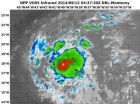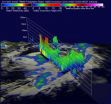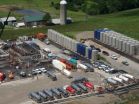(Press-News.org) The sixth tropical depression of the Atlantic Ocean hurricane season formed in the central Atlantic Ocean yesterday, and today, September 12, it strengthened into Tropical Storm Edouard. NASA-NOAA's Suomi NPP satellite flew over Edouard and provided forecasters with an infrared view of what's happening within the strengthening storm.
When Suomi NPP passed over Edouard on September 12 at 04:37 UTC (12:37 a.m. EDT), the Visible Infrared Imaging Radiometer Suite or VIIRS instrument aboard captured an infrared image of the storm. The infrared data shows temperature, an indicated that there were very high thunderstorms with very cold cloud top temperatures surrounding the center of the low level circulation.
VIIRS is a scanning radiometer that collects visible and infrared imagery and "radiometric" measurements. Basically it means that VIIRS data is used to measure cloud and aerosol properties, ocean color, sea and land surface temperature, ice motion and temperature, fires, and Earth's albedo (reflected light).
At 11 a.m. EDT (1500 UTC) the center of Tropical Storm Edouard was located near latitude 18.5 north and longitude 43.0 west. That's about 1,315 miles (2,120 km) east of the Northern Leeward Islands Edouard is moving toward the west-northwest near 16 mph (26 kph) and this motion with a gradual decrease in forward speed is expected during the next couple of days.
Maximum sustained winds have increased to near 45 mph (75 kph) and some slight strengthening is possible during the next two days.
Forecaster Avila of the National Hurricane Center noted that Edouard is moving toward the west-northwest at 14 knots (16 mph/26 kph) steered by the flow around the edge of a large elongated area of high pressure known as the Atlantic subtropical ridge. A gradual turn to the northwest and north is forecast in about 3 to 4 days when the ridge weakens.
The National Hurricane Center expects Edouard to become a hurricane by Monday, September 15 and stay east of Bermuda, curving back to the northeast.
INFORMATION:
Rob Gutro
NASA's Goddard Space Flight Center
NASA-NOAA Suomi NPP sees formation of Tropical Storm Edouard
2014-09-12
ELSE PRESS RELEASES FROM THIS DATE:
Worldwide study demonstrates accuracy of genetic analyses
2014-09-12
JACKSONVILLE, Fla., Sept. 12, 2014 — Physicians envision a future in which genomic data from patients is heavily used to manage care — but experts have questioned the accuracy and reliability of these analyses. Now, a study by 150 researchers in 12 countries finds real strength and agreement across RNA genomic sequencing techniques and laboratories — as well as ways to improve what little variability exists to set a new high standard.
The results of the study were published in Nature Biotechnology in three separate research articles.
These results should provide assurance ...
Tropical Storm Odile taken on by 2 NASA satellites
2014-09-12
As Tropical Storm Odile continues to affect Mexico's west coast and stir up dangerous surf, NASA's TRMM and Aqua satellites provided forecasters information on clouds and rainfall in the coast-hugging storm. On September 12, A Tropical Storm Watch remained in effect from Manzanillo to Cabo Corrientes, Mexico.
Tropical Storm Odile formed on September 10, 2014 in the same area where Norbert formed.
Gathering Rainfall and Thunderstorm Height Information
The Tropical Rainfall Measuring Mission or TRMM satellite flew over tropical storm Odile on September 11, 2014 at ...
CCNY analysis explains rich bird biodiversity in Neotropics
2014-09-12
Applying analyses designed by City College of New York biologist Mike Hickerson, a team of international researchers is challenging a commonly held view that explains how so many species of birds ended up in the Neotropics, an area rich in rain forest extending from Mexico to the southernmost tip of South America. It is home to the most bird species on Earth.
"The unanswered question has been—how did this extraordinary bird diversity originate?" said Dr. Brian Smith, lead author of a paper on the subject published in the journal Nature this week and an assistant curator ...
Fluid mechanics suggests alternative to quantum orthodoxy
2014-09-12
The central mystery of quantum mechanics is that small chunks of matter sometimes seem to behave like particles, sometimes like waves. For most of the past century, the prevailing explanation of this conundrum has been what's called the "Copenhagen interpretation" — which holds that, in some sense, a single particle really is a wave, smeared out across the universe, that collapses into a determinate location only when observed.
But some founders of quantum physics — notably Louis de Broglie — championed an alternative interpretation, known as "pilot-wave theory," which ...
Corn spots: Study finds important genes in defense response
2014-09-12
When corn plants come under attack from a pathogen, they sometimes respond by killing their own cells near the site of the attack, committing "cell suicide" to thwart further damage from the attacker. This cell sacrifice can cause very small, often microscopic, spots or lesions on the plant.
But up until now it's been difficult to understand how the plant regulates this "spotty" defense mechanism because the response is so quick and localized.
Researchers at North Carolina State University have identified a number of candidate genes and cellular processes that appear ...
Experts call for massive global response to tackle Ebola
2014-09-12
AUDIO:
Professor Peter Piot, Director of the London School of Hygiene & Tropical Medicine, explains how he co-discovered the Ebola virus in 1976, and gives his views on the current Ebola...
Click here for more information.
The current Ebola outbreak now requires a "rapid response at a massive global scale", according to experts at the London School of Hygiene & Tropical Medicine.
Writing an editorial in Science, Professor Peter Piot, co-discoverer of the virus, says that the ...
Stanford-led study assesses the environmental costs and benefits of fracking
2014-09-12
A strange thing happened on the way to dealing with climate change: Advances in hydraulic fracturing put trillions of dollars' worth of previously unreachable oil and natural gas within humanity's grasp.
The environmental costs – and benefits – from "fracking," which requires blasting huge amounts of water, sand and chemicals deep into underground rock formations, are the subject of new research that synthesizes 165 academic studies and government databases. The survey covers not only greenhouse gas impacts but also fracking's influence on local air pollution, earthquakes ...
Piglet health
2014-09-12
Porcine neonatal coccidiosis is a serious parasitic infection of young piglets that severely damages the intestinal mucosa, leading to diarrhoea and reduced nutritional intake. As the infection reduces animal growth, and because secondary infections can result in increased mortality, the disease is responsible for substantial economic losses at affected pig farms.
"The developing immune system of neonatal piglets is not yet mature enough to deal with the parasites. For this reason, an infection shortly after birth results in weakened intestinal tissue with appropriate ...
Moving silicon atoms in graphene with atomic precision
2014-09-12
Richard Feynman famously posed the question in 1959: is it possible to see and manipulate individual atoms in materials? For a time his vision seemed more science fiction than science, but starting with groundbreaking experiments in the late 1980s and more recent developments in electron microscopy instrumentation it has become scientific reality. However, damage caused by the electron beam is often an issue in such experiments.
The present study focused on single-layer graphene with silicon atoms embedded into the lattice, previously created and studied by the collaborators ...
Cutting the cloud computing carbon cost
2014-09-12
Cloud computing involves displacing data storage and processing from the user's computer on to remote servers. It can provide users with more storage space and computing power that they can then access from anywhere in the world rather than having to connect to a single desktop or other computer with its finite resources. However, some observers have raised concerns about the increased energy demands of sustaining distributed servers and having them up and running continuously, where an individual user's laptop might be shut down when it is not in use or the resources utilization ...



